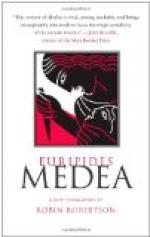|
This section contains 2,086 words (approx. 7 pages at 300 words per page) |

|
SOURCE: "Seneca," in The Villain as Hero in Elizabethan Tragedy, 1914. Reprint by Russell & Russell, 1964, pp. 13-20.
Boyer looks at Medea and Thyestes, Senecan plays in which the principals are cast as "villain-heroes," and he examines the possible influence of such characterization on Elizabethan drama.
The influence of Seneca on Elizabethan drama has been carefully though not exhaustively studied, so that there is general agreement as to the fact, if not the extent of his influence. To Seneca is usually attributed the introduction of the ghost and the chorus, the division of the play into five acts, as well as the introduction of various themes, such as revenge. It is the question of themes and the manner of treating them that concerns us here. All of Seneca's themes are violent and sensational. It is true that with the exception of Octavia they are taken from Greek sources, but owing...
|
This section contains 2,086 words (approx. 7 pages at 300 words per page) |

|


